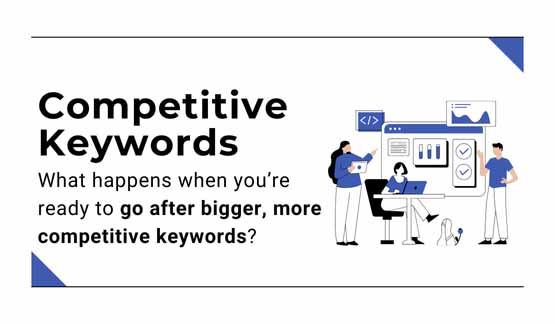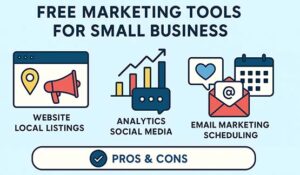Introduction: Climbing the SEO Ladder—At the Right Pace
If you’ve followed the first part of this series, you already know the secret to winning at SEO: start with keywords you can actually rank for. By focusing on low-competition, high-intent keywords, you can build momentum, generate traffic, and grow your authority faster than wasting months chasing unwinnable rankings.
But what happens when you’re ready to go after bigger, more competitive keywords?
That’s what this guide is all about. Even if you’re still working on easy wins, this article will help you map out your SEO strategy for the long run. Whether you’re ready to scale today or months from now, you’ll want to make sure you’re choosing the right battles—and not just jumping into the deep end unprepared.
In this guide, we’ll cover:
✅ How to know when you’re ready to target competitive keywords.
✅ A step-by-step strategy to move up the keyword ladder without getting stuck.
✅ How to keep winning easy rankings while preparing for tougher competition.
Let’s get started—because when you rank smart, you win bigger.
From Easy Wins to Strategic Competition
In the first part of this series, we focused on quick wins—keywords that were easy to rank for and brought in traffic with minimal resistance. These low-competition opportunities are an essential starting point because they allow you to build credibility, generate leads, and establish momentum without getting stuck in unwinnable SEO battles.
But eventually, you’ll start to outgrow those easy wins. As your site gains authority, you’ll need to expand your reach and compete for bigger, more competitive keywords that can drive even greater results. The challenge? Not all competitive keywords are worth the effort. If you move up too soon—or target the wrong terms—you risk wasting months chasing rankings you still can’t achieve.
The SEO Spectrum: Knowing Where You Stand
Think of SEO as a ladder.
1️⃣ At the bottom, you have low-competition keywords that are relatively easy to rank for. These are the foundation of early SEO success.
2️⃣ In the middle, you have moderately competitive keywords—terms that require some authority and backlinks but are still within reach.
3️⃣ At the top, you have the SEO heavyweights—high-competition keywords where large enterprises dominate, investing massive resources into ranking and maintaining their positions.
Where you are on this ladder determines what battles you should fight. If you try to skip steps—going straight from low-competition wins to ultra-competitive terms—you’ll struggle to gain traction. Instead, you need to level up strategically, tackling keywords that are more challenging but still realistically within reach.
The Smart Way to Move Up
SEO isn’t just about finding the most popular keywords—it’s about knowing when and how to compete. You don’t need to jump into the deep end right away, but at some point, you’ll hit a ceiling where your current keyword strategy isn’t enough. That’s when it’s time to shift your focus.
The key is to recognize when you’re ready and to move up in a way that maximizes your chances of success.
Step 1: Recognize the Signs You’re Ready
🔹 You’re Consistently Ranking for Low-Competition Keywords
If you’ve successfully ranked for multiple low-competition keywords and those pages stay on page one, that’s a sign Google trusts your content.
🔹 Your Organic Traffic Is Growing Without New Content
If older blog posts are continuing to bring in steady traffic and leads, it means your site’s authority is growing naturally—a good indicator you’re ready to target more competitive terms.
🔹 Your Domain Authority (DA) or Site Strength Has Improved
While DA isn’t a perfect metric, if tools like Moz, Ahrefs, or Semrush show a steady increase in your domain rating, backlink profile, or referring domains, you can start competing for tougher keywords.
🔹 Your Site Is Generating Leads & Revenue
If your SEO efforts are already driving business, you can justify investing more effort into harder-to-rank keywords that could bring in even bigger results.
Step 2: Use a Tiered Approach to Competitive Keywords
Jumping straight to a high-competition keyword is like trying to bench press 300 lbs on your first day at the gym. You need to build up strength first.
🔹 Start with Mid-Level Competition Keywords
Instead of going from low-KD to ultra-competitive terms, aim for keywords with:
✅ Moderate difficulty (30–50 KD)
✅ Strong search intent (clear buyer action)
✅ Still contain long-tail elements
🚀 Example:
If you originally targeted “best budget laptops under $500” (KD: 15), you can move up to “best budget laptops” (KD: 40) before tackling “best laptops” (KD: 80+).
🔹 Use Your Existing Content as a Launchpad
Instead of starting from scratch, optimize and expand your existing content to push it toward more competitive terms.
🚀 Example:
You rank for “roofing repair cost per square foot” but now want to target “roofing repair cost”—so you:
✅ Expand the content (add more in-depth cost breakdowns).
✅ Optimize with related terms (cover regional variations, material costs, labor pricing).
✅ Build internal links from supporting articles.
🔹 Adopt a Hub & Spoke Strategy
More competitive keywords require supporting content to build authority.
💡 How It Works:
1️⃣ Create a “hub” page for a high-competition keyword.
2️⃣ Support it with multiple “spoke” articles targeting related long-tail variations.
3️⃣ Internally link all spoke articles to the hub page—signaling to Google that you have a comprehensive topic authority.
🛠 Helpful Resource: Learn more about The Hub & Spoke Model: A Complete Guide.
Step 3: Use Paid Ads to Test Before Going All-In
Just like with low-competition keywords, test before you invest.
🔹 Run a Small Google Ads Test
✅ Spend $100–$200 on a PPC campaign for a higher-competition keyword.
✅ Track click-through rates & conversions.
✅ If it performs well, start working on ranking organically.
🚀 Example:
A law firm wants to rank for “best DUI lawyer in Dallas” (KD: 60). Before committing months of SEO work, they:
✅ Run a Google Ads campaign for 30 days.
✅ See how many clicks, calls, and consultations it generates.
✅ If the keyword drives high-value leads, they pursue it aggressively with SEO.
🛠 Helpful Resource: Learn more in What Is Paid Ad ‘Validation’ for Keywords, and How Does It Work?
Step 4: Strengthen Your Site to Compete at Higher Levels
SEO is part strategy, part strength training.
If you want to compete for tougher keywords, your site needs to level up in three key areas:
🔹 1. Content Depth & Quality
✅ Expand key articles (longer, more detailed, better multimedia).
✅ Cover more related subtopics (Google rewards topic depth).
✅ Keep content updated regularly (refresh outdated posts).
🔹 2. Authority & Backlinks
✅ Get featured on industry sites (guest posts, interviews, citations).
✅ Earn natural backlinks by publishing data-driven, original content.
✅ Use internal linking strategically to boost priority pages.
🔹 3. Technical SEO & User Experience
✅ Optimize page speed (fast sites rank better).
✅ Improve mobile experience (Google prioritizes mobile-friendly pages).
✅ Fix crawl errors & site structure (a well-structured site helps Google trust you).
🚀 Example:
A local plumber wants to rank for “best plumbing services” but their site is slow, outdated, and lacks backlinks. Before targeting a high-competition keyword, they:
✅ Upgrade site speed & mobile usability.
✅ Earn backlinks through local directories & partnerships.
✅ Expand content with how-to guides & case studies.
Once their domain authority increases, they go after the big terms.
Key Takeaways: Moving Up the SEO Ladder
✅ Don’t jump straight to ultra-competitive keywords. Use a tiered approach and build up over time.
✅ Mid-competition keywords (KD 30–50) are the perfect next step before going after high-KD terms.
✅ Use your existing content as a foundation. Expand, optimize, and internally link before creating brand-new pages.
✅ A Hub & Spoke model helps establish topical authority. Supporting articles help rank a main page faster.
✅ Paid ads help test competitive keywords before you invest months in SEO.
✅ To compete, your site needs strength. Improve content quality, backlinks, and technical SEO to break into tougher rankings.
🎯 Final Thought:
Moving from low-competition keywords to high-competition keywords isn’t about taking a huge leap—it’s about climbing the ladder one step at a time.
Master each level of keyword competition, and soon you’ll be ranking for the same high-value terms the industry giants dominate today.
Ready to take on bigger keywords? Let’s talk about how we can strategically grow your rankings. Reach out!
The Smartest Path to SEO Success
By now, you understand the hidden pitfalls of unwinnable keywords, how to find low-competition keywords that deliver results, and how to strategically move up the SEO ranks without wasting months on impossible goals.
Here’s the truth: SEO is both an art and a science.
If you go after keywords that are too competitive too soon, you’ll struggle for months (or years) with little to show for it. But if you focus on winnable keywords, you’ll gain traction, increase authority, and build the cash flow that eventually allows you to take on bigger opportunities.
But what if you don’t have the time (or desire) to figure all of this out alone?
You Could Try to DIY—But Is It Worth It?
Sure, you can invest in all the big-name SEO tools like Ahrefs, Semrush, and SurferSEO. You can spend weeks analyzing keyword data, testing different strategies, and optimizing pages to compete for top rankings.
💰 But here’s the catch:
✅ These tools aren’t cheap. A full suite of pro SEO tools can cost $500–$1,500+ per month.
✅ The learning curve is steep. Even with all the data, knowing how to interpret and apply it takes experience.
✅ Agencies and pros already have these tools (and know how to use them).
For most businesses, hiring a pro (who already has the tools) is far more cost-effective than buying them yourself—especially if you’re only using them for your own site.
The Best Approach? “Done With You” Instead of “Done For You”
Many businesses want a “Done For You” service, where someone else handles everything—from keyword research to SEO implementation. That’s great, but it often means you pay more and stay dependent on outside help.
That’s why we recommend a “Done With You” approach.
💡 What’s the difference?
✅ “Done With You” SEO = Lower cost, better results.
You get expert guidance, strategic input, and access to premium tools—but you stay involved, so you learn and retain control over your SEO.
✅ “Done For You” SEO = Higher cost, hands-off approach.
The agency handles everything—which is ideal if you want zero involvement. But it often costs more and doesn’t give you the skills to manage SEO long-term.
Which approach is right for you? It depends on your goals. But for businesses that want long-term, sustainable growth without breaking the bank, a “Done With You” strategy often delivers the best ROI.
Key Takeaways: The Smart Path to SEO Growth
✅ Chasing unwinnable keywords is a waste of time. Focus on winnable, low-competition keywords that actually convert.
✅ Once you’ve built traction, move up to more competitive keywords. Use a tiered approach and build authority step by step.
✅ You don’t need an expensive SEO tool suite. Hiring an expert who already has the tools is often cheaper than buying them yourself.
✅ “Done With You” SEO offers the best balance. You get expert strategy and hands-on guidance without the cost of full-service outsourcing.
Final Thought: Take the Next Step
Whether you’re just starting out or ready to move up to more competitive keywords, your next step is clear:
🎯 Stop wasting time on impossible rankings.
🎯 Focus on the right keywords at the right time.
🎯 Leverage expert guidance to get there faster.
Here’s the reality:
🚀 You don’t have time to do all this. You’re not a full-time marketer. I am.
I spend every day analyzing search results, testing strategies, and refining SEO tactics to help businesses grow. Instead of burning hours trying to figure it all out on your own, why not get expert guidance and a strategy that actually works?
Ready to rank for keywords that actually grow your business?
👉 Let’s talk. Book a call here.
Or, if you’re not quite ready for a call, check out:
📌 How to Identify and Avoid Unwinnable Keywords
🔹 Got questions? Get a FREE one-hour consultation! Let’s make SEO work for you—not against you. 🚀









